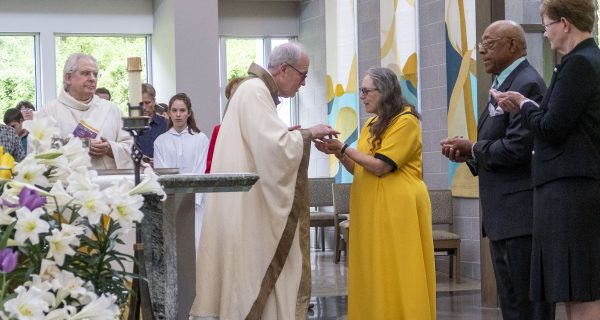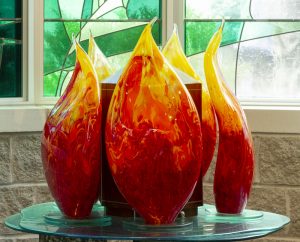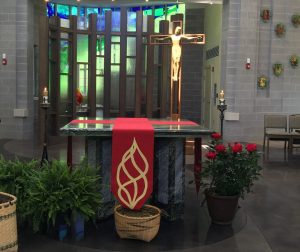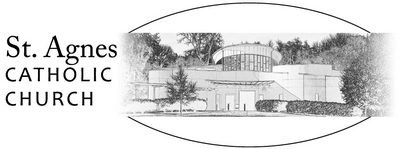Catholic Corner
June 6, 2021
 What is the difference between a communion service and a Eucharistic Liturgy?
What is the difference between a communion service and a Eucharistic Liturgy?
The Eucharistic Liturgy (what we do on Sunday) is the center of the sacramental life of the Church and the full celebration of the Eucharist is the norm for Sunday worship. Sometimes in emergency circumstances a communion service may occur. Communion services have a similar structure to the Eucharistic Liturgy, there are hymns sung, scripture is proclaimed, a homily or reflection may be given but there is something missing. During the Eucharistic Liturgy the entire assembly gathered around the one table, led by the priest, prays the Eucharistic prayer. In a communion service this action does not occur, hence at a communion service there is no consecration of bread and wine. Instead the reserved sacrament is brought from the tabernacle and given in communion. This in turn raises other questions.
What is the Eucharistic prayer?
This is the great prayer of thanksgiving of the Church. It is prayed after the gifts are brought up and it is a prayer that is voiced by the priest in the name of the entire community. God the Father is praised and thanked through our remembrance of the actions of the Son. God is asked to send the Holy Spirit upon the gifts of bread and wine and upon the gathered community who will share them. The once-for-all-actions of Christ (his death, resurrection, ascension and promise to come again) are remembered and in that remembering their effects are made present to us in our celebration. In this prayer we also join in the once-for-all offering of Christ to the Father through the offering of the gifts of bread and wine that become the Body and Blood of Christ. It is also a prayer of reconciliation, recalling the reconciliation of all won by Christ. The prayer reaches its high point at holy communion when the community shares in the Body and Blood of Christ, as the Body of Christ, to carry that Body forth in mission in the world.
Where does the communion used in a communion service come from?
The short answer is: it came from the tabernacle. The longer answer: The Church has an ancient tradition of reserving some of the sacrament for those who are ill or dying. From the very earliest Church, the presider would keep some of the bread consecrated on Sunday so that it could be given to those who were too ill to come to Church or who were dying (as food for the final journey). The communion used in a communion service is this reserved sacrament that is always kept in the tabernacle.
 What is a tabernacle?
What is a tabernacle?
The tabernacle is the container wherein the consecrated bread is reserved for those who are too ill to attend the Sunday Eucharistic Liturgy or for those who are dying. It began as a box kept by the priest in his residence, but eventually it developed into a container kept within the building of the Church. Our tabernacle is in the Reservation Chapel that is located behind the wood and glass screen behind the altar. It stands on a pedestal, surrounded by blown glass flames.
What is a Reservation Chapel?
A Reservation Chapel is a place set aside for the reservation of the reserved Eucharist. Besides the primary purpose of reservation (providing Eucharist for the sick and dying) there is a custom in the Catholic Church of praying before the reserved Eucharist. A Reservation Chapel provides an appropriate place for quiet, private prayer (as opposed to the public, communal actions of the gathered assembly during the Sunday Eucharistic celebration).
Why does the bread used at the communion service look different from the bread we normally use every Sunday?
On Sundays we normally (when we aren’t in a pandemic) use unleavened bread that is baked by members of our community. This is truly the “work of human hands” and it follows a recipe provided by the U.S. Conference of Catholic Bishops. It looks like bread and tastes like bread and hence it is a fuller expression of the symbol of Eucharistic bread than the wafers one often sees. However, it may be difficult for those who are ill or dying to consume this kind of unleavened bread, so as part of a Eucharistic celebration we also consecrate some communion wafers that are then reserved in the tabernacle.
What does the word “Eucharist” mean?
The word “Eucharist” comes from the Greek word eucharistia, which means “to give thanks.” In the Eucharist we give thanks to the Father, for the gift of the Son in the Spirit. We do so through word and ritual action. We listen to the Word, which reminds us who we are and having done so we move to table where we give thanks and praise and through the Great Prayer of the Church we celebrate and encounter Christ in the mystery of sacramental real presence.
What is the high point of the Eucharistic Liturgy?
The highpoint of the Eucharistic liturgy is communion! When we give and receive the Body and Blood of Christ, by the Body of Christ, to the Body of Christ, in order that we can become more and more the Body of Christ
What are the symbols of the Eucharist?
The symbols of the Eucharist include: the entrance procession (ritualized journey), the word proclaimed, the water with which we bless ourselves, the music we sing, the gathered community (the baptized, the Body of Christ, the People of God), the objects we use (bread, wine, Gospel Book, cross, ambo, table, font, etc) to name just a few.
What are the parts of the Eucharist?
The Eucharist consists of two main parts: The liturgy of the word (Three readings, psalm, homily, creed, prayers of the faithful) and the liturgy of the Eucharist (bringing up the gifts, proclaiming the Eucharistic Prayer, Communion).
What mystery are we encountering in the Eucharist?
The primary mysterion we encounter is the mystery of Christ himself, Christ as primary sacrament. By this we mean that through Christ, in the Eucharist, we encounter the mystery of God in deeper and more profound ways. This encounter transforms our experience of very ourselves and who we are called to be by our baptism.
Why is it called “Sacramental” Real Presence?
The word sacrament comes from the Latin word sacramentum that is itself a translation of the Greek word mysterion. Sacraments are invitations into the mystery of God and they communicate this mystery through the language of symbol.
Where does the Church fit into this understanding of sacrament?
The Church is the continuous mysterion/sacramentum of Christ in the world. Through the Church, we the baptized, are to live as Christ lived. We are to be compassionate, forgiving, merciful and inclusive. We are the Body of Christ in the world.
 What is sacramental real presence?
What is sacramental real presence?
The presence of Christ in the Eucharist is a sacramental one. It is an invitation into the mysterion (mystery) of Christ. It is transformative – a charged encounter with the reality of Christ that transforms us into a new reality. To do this though, we need to repeat this experience over and over again. Only by celebrating this reality repeatedly will its’ meaning be instilled in our lives.
Where do symbols fit into this understanding?
The Eucharist communicates its meaning through symbols. Symbols are the language of sacraments, they have many meanings, they are inexhaustible. They invite us into the mystery of God through their depth of meaning.
What are the symbols involved in sacramental real presence?
These are the symbols of the Eucharistic celebration. Sacramental Real Presence takes into consideration the entire celebration: the word proclaimed, the community gathered, action, object and event. “The body of Christ is not only on the table but at the table.” As St. Augustine once said: “Be what you receive and receive what you are.” You are the Body of Christ. Through sacramental real presence we encounter the mystery of God, and we grow more and more deeply into this mystery, being transformed by this encounter.
What is the oldest description of the Eucharist in the Bible?
It is Pauls’ First Letter to the Corinthians. written between 53 – 57 C.E. In Chapter 11 Paul tells us he is passing on a tradition he himself received, and he goes on to discuss the meaning of the Eucharist as an action of remembrance (“do this in remembrance of me”) and participation with Christ.
What did the early Eucharist look like?
It looked a great deal like what we do today! According to the writings of Justin Martyr (150 C.E.), the community gathered on Sunday, they sang, they listened to the scriptures, there was a homily, the community presented their gifts and then gathered around the table, they offered the great prayer of thanksgiving to the Father, through the Son, in the Spirit, over the gifts of bread and wine and then ate and drank as Christ commanded.
Why do we get baptized only once but we celebrate the Eucharist repeatedly?
Baptism is about entry into the Body of Christ. We only enter once. We celebrate the Eucharist repeatedly because by repeating this action we appropriate its meaning into our lives. Repeated encounters instill that meaning more deeply. It inculcates it into our being. Eucharist is a transformative encounter. Through our celebrations we are changed. By praying well, we are changed. We grow more fully into the People we are called to be. So it matters how we pray, how we sing, move, give thanks and praise as a community to God
How does Eucharist meet our life beyond the Sunday celebration?
By gathering every Sunday we more deeply enter into the mystery of Christ and are ever more deeply transformed. We live this transformation beyond the doors of the Church by living the mission of the Church, to carry on the mission of Christ in the world and help to bring forth the reign of God.
